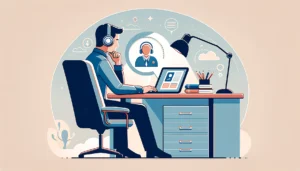Mastering skills-based learning: the tech making the shift quicker and more rewarding
- 5 Min Read
There’s a shift taking place across workplaces worldwide in which skills are, finally, being prioritised above job roles, above experiences, and above qualifications. After decades of talent shortages and widening skills gaps, HR leaders are realising that the legacy L&D and hiring practices of old are no longer fit for purpose. To keep up with […]
- Author: David James
- Date published: Mar 12, 2024
- Categories

There’s a shift taking place across workplaces worldwide in which skills are, finally, being prioritised above job roles, above experiences, and above qualifications. After decades of talent shortages and widening skills gaps, HR leaders are realising that the legacy L&D and hiring practices of old are no longer fit for purpose.
To keep up with the shifting needs of businesses, as well as employee demands, a rising number of organisations are looking to embrace a skills-first strategy.
The reasons why are clear. Organisations with a skills-based approach are 98% more likely to retain high performers. They’re 63% more likely to exceed financial targets, and having a skills-first framework helps improve diversity, productivity and employee engagement.
That’s before the wider implications of helping to address the growing skills gap are factored in. Gartner data shows that the number of skills required for a single job is increasing by 10% every year, and more than 30% of the skills needed three years ago will soon be irrelevant. By focusing on skills first, companies can stay on top of, and even get ahead of, this rapid pace of change.
Yet despite a significant rise in interest among organisations, and the ever-growing urgency of the skills crisis, many companies lack the maturity to make the switch. In fact, only 10% of companies have actually adopted this approach.
The problem? Not knowing where to start.
Skills-based learning as a gateway
Taking a skills-based approach isn’t new but the rising popularity and advancement of tools such as AI have pushed it into the limelight. Not just because AI and automation are transforming the labour market in almost real-time, putting pressure on CHROs to keep up, but because of the technologies’ ability to handle many of the complex nuances needed to switch to a skills-based strategy.
Nowhere is this as impactful as in skills-based learning. For businesses just starting out on their skills-first journey, skills-based learning is the ideal entry point, both in terms of getting buy-in from teams but also technologically speaking.
Harnessing the power of skills-based tech
AI-powered skills tech can map and benchmark skills, helping organisations create useful ontologies and even map potential and personalised career paths for individual employees. This helps an organisation track the availability of in-demand skills, create internal skills marketplaces and foster strong internal talent pools.
It also demonstrates to staff the company’s commitment to their own personal development. A recent 360Learning study found that employees who can’t see where their next internal move might come from are more inclined to leave. Using skills-based learning to create a capable and engaged workforce benefits the organisation by increasing motivation and employee satisfaction.
Using an AI skills platform also means this mapping is dynamic and up-to-date, instead of something that is only looked at once every few years. This helps organisations to more accurately close the gap, in skills as well as diversity, while doubling down on employee retention.
Greater visibility into value
There’s also a direct economic incentive to switch to skills-based learning. Hundreds of billions of dollars are spent on legacy learning tech each year that is either loathed or ignored by employees. By comparison, not only do skills-based, AI-powered tools increase employee engagement by 23% (and boost performance by 18%), but the tools themselves make it easier to track results. A tool that identifies skills gaps, for instance, reveals where the pain points are and where investment is needed while also monitoring progress against key business goals, thus giving a more actionable ROI.
When AI-powered collaborative learning is added to this mix, course completion and engagement scores soar to 91%. This is because it allows companies to quickly identify what courses are missing or need to be improved, speed up course delivery, ensure learners find courses tailored to their needs and keep growing through constant learning.
Harnessing technological change
The rapid pace of technological change is seen to be fuelling the labour problem but when used effectively in key areas such as HR and L&D, skills-based AI is the solution. It’s the solution to addressing the talent shortage and quickly upskilling and reskilling people to fill skills and diversity gaps.
It solves the problems around access and equity by democratising access to high-quality, skills-based learning for more people, and it helps companies meet the growing demand from today’s workforce for personalisation.
Taking a skills-based approach is emerging as no longer a nice to have, but a key competitive advantage. Skills-based learning is the gateway to unlocking this advantage and AI-powered, skills-based tech holds the key to opening this gateway.
David James is an L&D expert, having worked in the industry for nearly 30 years including as Director of Learning and Development at Disney. Since 2022, he has been Chief Learning Officer at 360Learning, the global collaborative learning leader.









